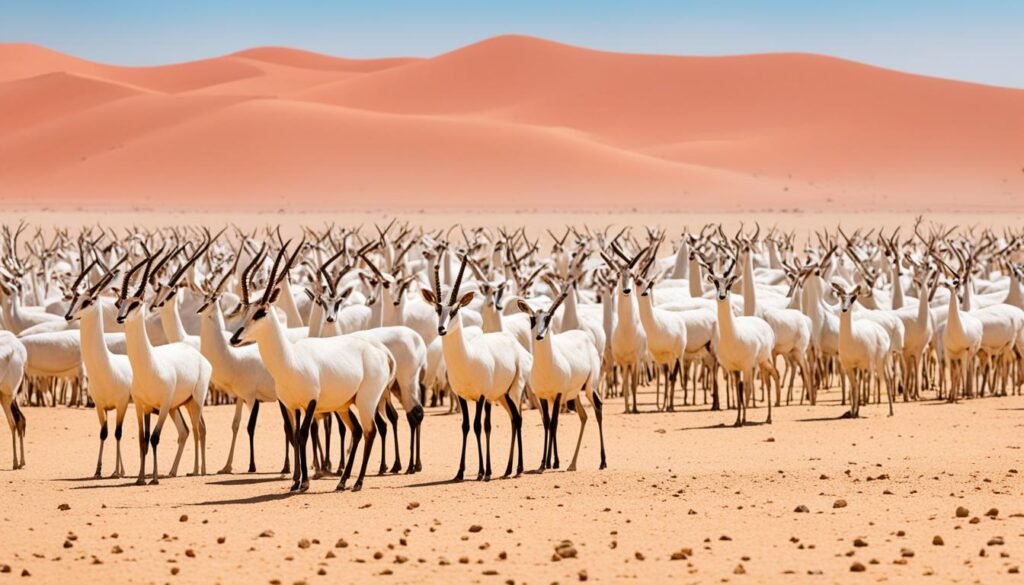The United Arab Emirates is known for its skyscrapers, luxury lifestyle, and modern cities, but there is another side to the country that often goes unnoticed—its deep commitment to protecting nature and environment.
Over the last few years, the UAE has taken strong steps to conserve nature and promote sustainability. From restoring mangrove forests to protecting endangered species, the country is investing heavily in a greener future, both for its people and for the planet.
Protecting Native Wildlife
One of the UAE’s biggest environmental priorities is protecting endangered animals that live in the desert. The Arabian oryx, a beautiful white antelope with long horns, was once nearly extinct in the wild. But today, thanks to strong conservation programs led by both government and private groups, this iconic animal is thriving again.

Similar efforts are being made for other species like the Arabian leopard and the Houbara bustard, a rare bird that migrates across the region. Wildlife reserves have been set up across the country, especially in Abu Dhabi, Sharjah, and Ras Al Khaimah, where these animals can live safely and breed under protection.
The UAE has also banned hunting and introduced breeding programs to reintroduce endangered animals into their natural habitats. These steps are helping restore the delicate balance of desert ecosystems that have been threatened by development and climate change.

Restoring Mangroves and Coastal Areas
Mangroves play a huge role in keeping the UAE’s coasts healthy. They protect against storms, store carbon, and provide homes for birds, fish, and marine life. That’s why the UAE launched one of the largest mangrove planting projects in the region.
By 2030, the country plans to plant more than 100 million mangrove trees. These efforts are already visible in areas like Jubail Mangrove Park in Abu Dhabi, which has become a popular spot for nature lovers and tourists.
Beyond mangroves, marine reserves and coral restoration projects are also underway. These programs are not just about planting trees or cleaning beaches—they’re about rebuilding entire ecosystems from the ground up.
Going Green in the Cities
Urban areas are also being transformed with greener goals in mind. The UAE has introduced environmental standards for new buildings, promoting energy efficiency, water conservation, and sustainable materials.
Dubai, for example, aims to become one of the most sustainable cities in the world. Through its Dubai 2040 Urban Master Plan, the city is increasing green spaces, improving air quality, and designing smarter infrastructure. Solar panels are becoming common on rooftops, and new neighborhoods are being designed with walking paths, bike lanes, and public parks.
Sharjah and Abu Dhabi have also introduced programs that reduce single-use plastics, promote recycling, and educate the public about environmental responsibility. School programs, workshops, and community clean-up events are now a regular part of life.
Protected Areas and National Parks
To ensure long-term conservation, the UAE has established over 49 protected areas across land and sea. These include national parks, nature reserves, and wetlands that are home to thousands of species of plants and animals.

Al Wathba Wetland Reserve near Abu Dhabi is one of the most successful examples. Once a forgotten area, it is now a thriving wetland that attracts thousands of flamingos each winter. Visitors can walk through the reserve, observe birds, and learn about wetland ecosystems.
Another notable site is the Hatta Mountain Conservation Area in Dubai, which promotes eco-tourism while preserving the mountain environment. Tourists can enjoy hiking, kayaking, and camping while respecting the natural landscape.
These protected areas are also vital for research. Scientists and environmentalists use them to study how ecosystems respond to climate change and human impact. The findings help the government make better decisions about conservation policies and laws.
Solar Energy and Climate Goals
Conservation isn’t just about trees and animals—it’s also about how we use energy. The UAE is investing billions in clean energy projects that will reduce carbon emissions and protect the environment in the long term.
The country is building the world’s largest solar farm in Abu Dhabi—Noor Abu Dhabi—and has already launched the Mohammed bin Rashid Al Maktoum Solar Park in Dubai. These projects aim to supply much of the country’s power through renewable sources, reducing the need for fossil fuels.
The UAE has also made a bold commitment to reach net zero carbon emissions by 2050. This means the country will work to balance the amount of carbon it releases with the amount it removes from the atmosphere. It’s a major step forward in the global fight against climate change.
The Role of Local Communities
What makes the UAE’s conservation efforts truly effective is the involvement of local communities. The government is not working alone—citizens, schools, businesses, and volunteers all play a role.

Youth-led environmental groups are on the rise, spreading awareness about recycling, sustainability, and eco-friendly habits. Social media campaigns and public events help people stay informed and involved.
Local farmers are also being supported to use modern, water-saving techniques to grow crops. The aim is to reduce the pressure on freshwater sources while still supporting food production in a desert environment.
Looking Ahead
The UAE understands that protecting nature is not just a responsibility—it’s a necessity. With rising temperatures, scarce water resources, and fragile ecosystems, the country knows that now is the time to act.
By combining modern technology, traditional knowledge, and community action, the UAE is setting an example for other nations in the region and beyond. The journey is not over, but the direction is clear: a future where people and nature thrive together.
As more projects roll out and awareness grows, the UAE’s conservation story continues to unfold—one tree, one animal, and one community at a time.
Also read: How the UAE is Leading the Green Travel Revolution













